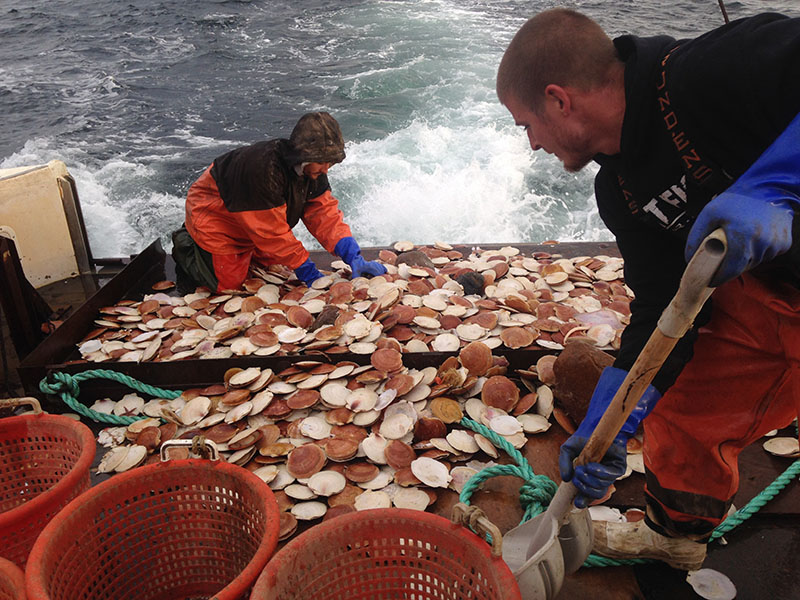The Atlantic sea scallop fishery — predominantly centered around New Bedford, Mass.; Point Judith, R.I.; Cape May, N.J.; and Norfolk, Va., ports — is the largest and most valuable wild scallop fishery in the world. Projected landings in the federal fishery are expected to be around 40 million pounds in 2021.
“The allocation was developed using survey data from 2020, and then projecting growth, harvest, natural mortality and recruitment,” says Jonathon Peros, fishery analyst and scallop lead at New England Fishery Management Council.
In 2019, commercial landings of Atlantic sea scallops totaled more than 60.6 million pounds (shucked meats) valued at around $570 million. Landings have dropped by 10 million pounds per year the last two years.
“This was expected,” adds Peros. “There were two exceptional year classes in 2012 and 2013 that the fishery has been catching. We are in the twilight of those two cohorts.”
Despite expected declines in landings this fishing year, prices in late April were up, particularly for the largest market grades (U10 and U12). Prices on the New Bedford auction surpassed $30 per pound for U10s and U12s. “Prices on all market grades are up from where they were at this time last year,” adds Peros.
Alex Todd is a Maine scallop fisherman who harvests in both the Maine state and Northern Gulf of Maine federal fishery. In the state fishery, “things have been good abundance-wise, good being the correct word,” says Todd. “For the state fishery, western Maine is not known as a hotspot [so] it takes longer to get the limit.” During the Maine season, boat prices were high, “up 2 to 3 bucks from last year,” adds Todd. At Harbor Fish Market in Portland, Maine, dayboat U-10/20 scallops were $23.99 per pound and had been inching up in price. Jumbo scallops were $28.99 per pound for retail customers.
As for the federal fishery, Todd says prices have been even higher than before, especially for the larger sizes. “In the NGOM area, with what bottom is open this year, it’s a long day,” he says. “I say it’s good, for what is open. The days are long, and the fuel bill is up. But nobody said it was gonna be easy, and we get there in the end.”
As expected, NMFS announced a May 6 closing for the northern gulf after projecting that 100 percent of the 2021 default total allowable catch there would be taken. That closure goes through the end of the fishing year, March 31, 2022.
“It ends the season. So it ends the scallop income and at big prices,” says Todd. “But it was expected. Actually I kinda feel like I got a little bonus. Don’t get me wrong, I wish it was longer, but this is what we expected.”
Meanwhile to the south, “a substantial portion of the limited access fleet has spent the start of the fishing year working the open bottom on Georges Bank to the west of the Closed Area II access area catching a mix of scallop grades (U 10-20, 20-30s). Catch rates in this area have been better then we predicted,” says Peros. The council continues to use rotational management in the scallop fishery.
“For 2021, part of the Closed Area II rotational area will be closed to protect recruitment,” says Peros, “while another part of this area will reopen to access area fishing.” The closures are aimed at improving yield-per-recruit, and the scallops in that area are mostly too small (at the moment) to be retained by the 4-inch ring in the scallop dredge.
Todd says he is impacted by both state and NGOM closures. He feels it mainly in fuel consumption and hours spent to hit the limit. “The loss is basically in trip expenses, not pounds landed,” adds Todd. But this year’s strong market prices certainly help “offset extra fuel expenses.”
In the northern Gulf of Maine, Stellwagen Bank will be closed again this year to protect an area first noticed in 2019. “Last year’s surveys confirmed that those scallops were still on the bank, and growing, but that yield could be improved with another year of closure to allow more growth,” says Peros.
“In the NGOM area, the Stellwagen closures greatly affects the gallons of fuel used a day to reach the limit,” says Todd. “Also, it affects the wear on the drag, boat engine, and all the gear. But hopefully, we feel the benefit of waiting for access for years to come.” An optical and dredge survey is planned for this year, says Peros, “and we’ll know a lot more about the outlook for the Stellwagen area this fall.”
The implementation of new allocations was delayed this year because regulators opted to consider results of the 2020 resource surveys, which had been delayed because of NMFS’ covid-19 safety precautions. New allocations are expected to go into place in May.







